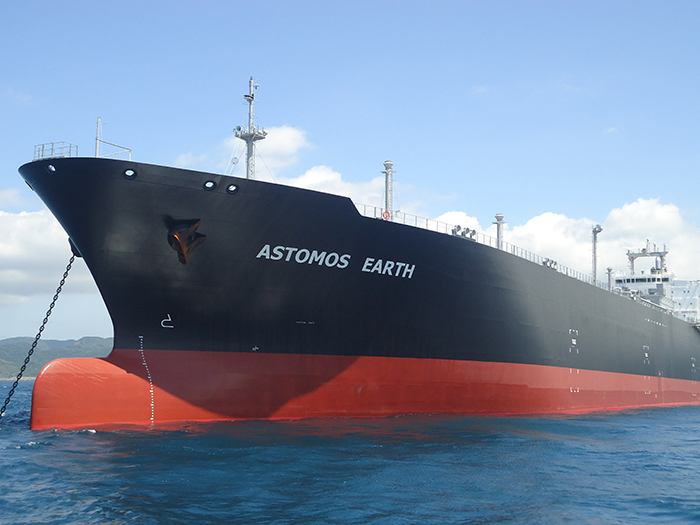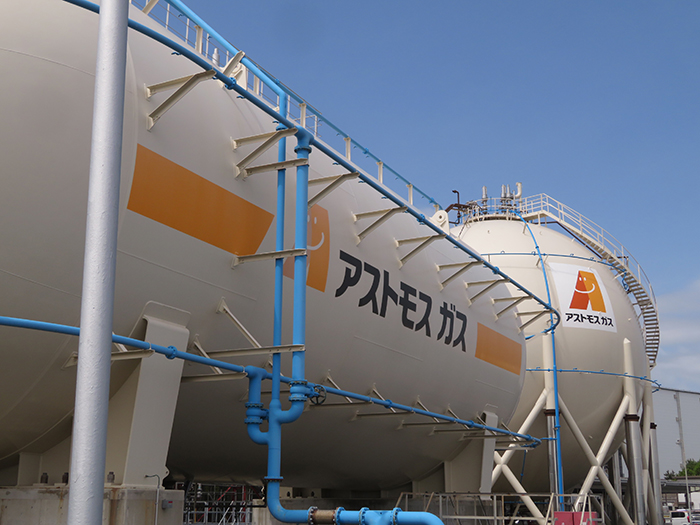2023.10.19

Why Carbon Neutral LPG Supplied by Astomos Energy is Said to Be Disaster Resilient
Drawing a lesson from the prolonged power outage wrought by a typhoon in 2019, Isumi City in Chiba Prefecture is pushing forward its plan to strengthen the city’s disaster resilience. As part of the disaster prevention and business continuity plan (BCP), in March 2023 the city completed the construction of a microgrid that includes power generators that run on carbon neutral liquified petroleum gas (LPG) supplied by Astomos Energy. Takayoshi Okamoto from the Green Business Development Office and Kosuke Hino from the Wholesale Department of Astomos Energy’s Domestic Business Division explain the future outlook of LPG, which is said to be resilient against disasters.

Adopted by Isumi City, Chiba Prefecture, LPG is the “last resort” in times of disaster.
Microgrids, or small-scale power generation systems, are local systems that generally
convert solar, wind, and other forms of renewable energy into electricity. Renewable sources
depend on natural conditions and are therefore subject to fluctuations, which makes it
difficult to use them to instantly provide a stable supply of electricity in the event of a
major power outage. This means that power generators are also needed in order to maintain
the balance between the supply and demand of electricity over long periods during a
disaster.
Isumi City adopted a gas bulk system capable of storing 2.9 tons of LPG along with LPG power
generators that can run for 72 hours non-stop. To maintain a stable supply of electricity in
the event of a power outage, the LPG power generators will be started first, followed, in
phases, by the solar power generation equipment and secondary batteries.
Why was LPG chosen as the energy source of the power generators? The reason is that LPG is
more resilient against disasters compared with gasoline or light oil. “LPG shows almost no
degradation, even when stored over a long period of time,” explains Mr. Okamoto. “Also, when
stored in cylinders, it becomes an easily portable, distributed energy source. It can also
ensure a stable supply-demand balance. Isumi City chose LPG partly due to such features,
which enhance its BCP.”
As disasters become more severe and frequent due to climate change, more municipalities are
expected to build microgrids in the coming years.
According to Mr. Okamoto: “To maximize the benefit of installing an energy supply system in
a locality, the needs of residents and the issues they face should be examined in order to
build a microgrid that is best suited to the area.
“This is where LPG can contribute. Its extensive supply network reaches every corner of the
country, which allows fuel to be supplied even when transportation and logistics functions
are disrupted. This is why LPG is, under Japan’s Basic Energy Plan, considered to be the
‘last resort’ in energy supply during a disaster.”
Astomos Energy becomes the world’s first purchaser of carbon neutral LPG toward the goal of achieving a low-carbon society by 2030.

Isumi City uses carbon neutral LPG (CNLPG) to fuel its LPG power generators. CNLPG is LPG
whose CO2 emissions are offset throughout the value chain from mining to final
consumption, including transportation, which means that the LPG can be used with virtually
zero CO2 emissions. In 2021, Astomos Energy made the world’s first purchase of
CNLPG in the amount of a VLGC (Very Large Gas Carrier), which it sold in the domestic
market. According to Mr. Hino, “Demand [for CNLPG] has continued to grow since then.”
“LPG characteristically emits less CO2 compared with other fossil fuels such as
oil and natural gas,” he continues. “With cleaner combustion emissions, LPG is
environmentally friendly and saves energy and money. This is why we were quick to decide on
importing CNLPG ahead of others as part of our efforts to accelerate the energy transition
toward a low carbon society in 2030 and, eventually, carbon neutrality in 2050. Existing LPG
users can, by adopting CNLPG, reduce CO2 emissions without having to replace
their facilities. For fuel oil users, switching their energy source to CNLPG means energy
and cost savings and reducing CO2 emissions at the same time.”
Thus, Astomos Energy regards CNLPG as a means of effecting the energy transition.
According to Mr. Okamoto: “The LPG industry, including our company, is making concerted
efforts to develop technologies for manufacturing ‘green LPG,’ which is LPG made by using
CO2 and hydrogen generated from cattle manure and food waste, which would
otherwise be discarded, and emissions from plants. The aim is to achieve zero CO2
emissions in the entire process from production to consumption.
“As mentioned earlier, the initiative will allow users to achieve carbon neutrality without
replacing their existing facilities. There are several ways to synthesize green LPG, and
research is underway to create larger facilities for this at lower costs, so it will still
take some time to commercialize the product. We hope to gradually increase the use of green
LPG by 2030 while also utilizing CNLPG, and also adopt and supply other materials that help
us achieve low carbon and carbon neutrality.”
As Mr. Hino explains, “The aim of the LPG industry is to achieve carbon neutrality, not zero
emissions. While striving for greener energy, we also believe that it will be imperative to
keep using fossil-derived gas in combination with CO2 capture technology and
other means. Astomos Energy will keep working to meet the needs of a carbon neutral society
by endeavoring to establish new environmental businesses and technologies in addition to
proliferating CNLPG.”
LPG is thus highly anticipated to contribute to disaster preparedness and carbon neutrality.
INTERVIEWEE

TAKAYOSHI OKAMOTO
Green Business Development Office

KOSUKE HINO
Wholesale Department, Domestic Business Division
Astomos Energy Corporation
Sapia Tower 24F, 1-7-12 Marunouchi, Chiyoda-ku, Tokyo
Established in 2006 as the successor to Mitsubishi Liquified Gas Co., Ltd., founded
in 1962. One of the world’s largest LPG distributors, Astomos Energy procures LPG
from a variety of regions around the world and delivers industrial- and
household-use LPG through its integrated supply/sales system. LPG is used by half of
the approximately 50 million households in Japan, and the company holds around 24%
of the domestic market share.
